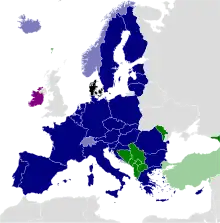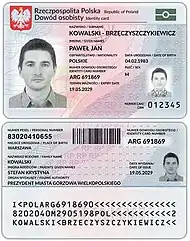National identity cards in the European Economic Area
National identity cards are issued to their citizens by the governments of most European Economic Area (EEA) member states, the exceptions are Denmark and Ireland. Ireland however issues a passport card which is a valid document in the EEA and Switzerland.[13] Denmark issues simpler identity cards that are not valid as travel documents.[14][15] From 2 August 2021, new identity cards are harmonized as a common identity card model replaced the various formats already in use. There are approximately 200 million national identity cards in use in the EU/EEA, including 53 million of the new EU-standard cards.[16] They are compulsory in 14 EU countries, voluntary in 9 countries and in 8 countries they are semi-compulsory (some form of identification required). Where the card is compulsory, in some member countries it is required to be carried at all times, while in other countries the mere possesion of the card is sufficient.[17]
| National identity card | |
|---|---|
.jpg.webp) _(Front).png.webp) Examples of European standard ID cards issued in Finland and Norway. ID cards issued in Iceland, Liechtenstein and Norway do not feature the EU flag. | |
| Type | Identity card |
| Issued by | |
| First issued | 2 August 2021 (New EU-standard) |
| In circulation | 53 million (2023, new EU-standard))[1] ~200 million (total)[2] |
| Valid in |
Various other countries and territories depending on the country of issue |
| Eligibility | Citizens of the European Economic Area |
| Expiration | New cards: Maximum 10 years Non-MRZ: 2 Aug 2026 |
| Size | ID-1 |
Citizens holding a national identity card, which states citizenship of an EEA member state or Switzerland, can use it as an identity document within their home country, and as a travel document to exercise the right of free movement in the EEA and Switzerland.[18][19][20] However, identity cards that do not state citizenship of an EEA member state or Switzerland, including national identity cards issued to residents who are not citizens, are not valid as travel documents within the EEA and Switzerland.[21][22][23]
Use
Travel document
As an alternative to presenting a passport, EEA and Swiss citizens are entitled to use a valid national identity card as a stand-alone travel document to exercise their right of free movement in the European Economic Area and Switzerland.[18][19][20] National identity card ownership in most EU countries and Switzerland is much more widespread than passport ownership.[24]
When travelling within the Nordic Passport Union, no identity documentation is legally required by Nordic citizens. When travelling within the Common Travel Area, other valid identity documentation (such as a driving licence) is often sufficient for Irish and British citizens.[25]
At present, Denmark and Iceland do not issue identity cards that are valid as travel documents in the EEA member states and Switzerland.[26] Strictly speaking, it is not necessary for an EEA or Swiss citizen to possess a valid national identity card or passport to enter the EEA and Switzerland. In theory, if an EEA or Swiss citizen can prove their nationality by any other means (e.g. by presenting an expired national identity card or passport, or a citizenship certificate), they must be permitted to enter the EEA and Switzerland. An EEA or Swiss citizen who is unable to demonstrate their nationality satisfactorily must, nonetheless, be given 'every reasonable opportunity' to obtain the necessary documents or to have them delivered within a reasonable period of time.[27][28][29]
Additionally, EEA and Swiss citizens can enter the following countries and territories outside the EEA and Switzerland on the strength of their national identity cards alone, without the need to present a passport to the border authorities:
|
|
Turkey allows citizens of Belgium, Bulgaria,[47] France, Germany, Greece, Hungary, Italy, Liechtenstein, Luxembourg, Malta, Netherlands, Poland, Portugal, Spain and Switzerland. Egypt allows citizens of Belgium, France, Germany, Italy, and Portugal to enter using a national identity card for short-term visits.[48][49] Tunisia allows nationals of Austria, Belgium, France, Germany, Italy, Luxembourg, Netherlands, Portugal, Spain, Sweden, and Switzerland to enter using a national identity card if travelling on an organized tour. Anguilla, Dominica, Saint Lucia and Jersey allow nationals of France to enter using a national ID card, while Dominica de facto also allows nationals of (at least) Germany and Sweden to enter with a national ID card (as of March 2016). Gambia allows nationals of Belgium to enter using a national ID card.[50] The United Kingdom and the Crown Dependencies only allows EEA (except Irish) and Swiss citizens fulfilling specific requirements to use national identity cards (though to enter at the land border Ireland-Northern Ireland, no specific document requirements apply).[51][52][53][54][55] Greenland allows Nordic citizens to use any identification document containing a photo, while citizens from the rest of EU/EFTA must carry a passport.[56]
Swedish national law did not recognise the card as a valid travel document outside the Schengen Area,[57] in direct violation of European law, until July 2015, when travel to non-Schengen countries in the EU (but not outside, even if the destination country accepts the ID card) was permitted.[58] Similarly, Finnish citizens cannot leave Finland directly for a non-EU/EFTA country with only their ID cards.[59]
Additional checks for some citizens
At the external border crossing points of the Schengen Area, if a traveller presents a travel document without a machine readable zone and the border guard has 'doubt about his/her identity', the traveller may be requested to undergo a more in-depth 'second line' check.[28] In practice, this means that Greek citizens who present an old-format Greek identity card and Italian citizens who present an Italian paper identity card could be subject to additional checks and delay when entering/leaving the Schengen Area.[60]
With effect from 7 April 2017, it is mandatory for border guards in the Schengen Area to check on a systematic basis the travel documents of all EEA and Swiss citizens crossing external borders against relevant databases.[61] Until 7 April 2017, border guards in the Schengen Area were only obliged to perform a 'rapid' and 'straightforward' visual check for signs of falsification and tampering, and were not obliged to use technical devices – such as document scanners, UV light and magnifiers – when EEA and Swiss citizens presented their passports or national identity cards at external border checkpoints.[62] They were not legally obliged to check the passports/national identity cards of EEA and Swiss citizens against a database of lost/stolen/invalidated travel documents (and, if they did so, they could only perform a 'rapid' and 'straightforward' database check, and could only check to see if the traveller was on a database containing persons of interest on a strictly 'non-systematic' basis where such a threat was 'genuine', 'present' and 'sufficiently serious').[62]
According to statistics published by Frontex, in 2015 the top 6 EU member states whose national identity cards were falsified and detected at external border crossing points of the Schengen Area were Italy, Spain, Belgium, Greece, France and Romania.[63] These countries remained the top 6 in 2016.[64]
Identification document
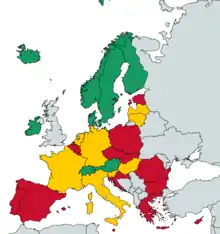
- Usage in own country
There are varying rules on domestic usage of identity documents. Some countries demand the usage of the national identity card or a passport. Other countries allow usage of other documents like driver's licences.
In some countries, e.g. Austria, Finland, Sweden and Iceland national identity cards are fully voluntary and not needed by everyone, as identity documents like driving licences are accepted domestically. In these countries only a minority have a national identity card, since a majority have a passport and a driving licence and don't need more identity documents. This is also true for Ireland where those who have a passport and a driving licence have less need for the passport card. The passport card can be used for travel to 31 countries in the European Union, European Economic Area including Switzerland.[65]
However, even in those EEA countries that impose a national identity card requirement on their citizens (above certain age), it is generally not required to carry the identity cards at all times.
- Usage outside own country
EEA and Swiss citizens exercising their right of free movement in another EEA member state or Switzerland are entitled to use their national identity card as an identification document when dealing not just with government authorities, but also with private sector service providers. For example, where a supermarket in the Netherlands refuses to accept a German national identity card as proof of age when a German citizen attempts to purchase an age-restricted product and insists on the production of a Dutch-issued passport or driving licence or other identity document, the supermarket would, in effect, be discriminating against this individual on this basis of their nationality in the provision of a service, thereby contravening the prohibition in Art 20(2) of Directive 2006/123/EC of discriminatory treatment relating to the nationality of a service recipient in the conditions of access to a service which are made available to the public at large by a service provider.[66] In those EEA countries whose citizens are required by law to obtain a national identity card, only a minority have a passport, since it is not needed for travelling across much of Europe.
- Usage in third countries
National identity cards are often accepted in other parts of the world for unofficial identification purposes (such as age verification in commercial establishments that serve or sell alcohol, or checking in at hotels) and sometimes for official purposes such as proof of identity and nationality to authorities (especially machine-readable cards).
As of 1 July 2021, EEA (except Irish) passports and identity cards are no longer accepted to prove the right to rent in the United Kingdom, so EEA citizens are required to provide evidence of lawful immigration status.[67]
Electronic identity cards (eID)
A total of 17 EU countries issue eIDs on their national identity cards, with some being mandatory, others upon request from their user. 14 EU countries issue national identity cards with an electronic identity (eID) function through an EMV (contact chip). 3 EU countries (The Netherlands, Italy and Germany) have a RFID/NFC integration that allows the same eID functions by contactless, without an EMV chip, such as Italy and Germany. The regulation dictates that the eID functions must be logically or physically separate from the ICAO biometric function of the card. [16]
Digital signature applications can be used which, upon activation, enables the bearer to authenticate the card using their confidential PIN.[68] Consequently they can authenticate documents to satisfy any third party that the document's not been altered after being digitally signed, as well as to identify the identity card holder. This application uses a registered certificate in conjunction with public/private key pairs so these enhanced cards do not necessarily have to participate in online transactions.[69] This can be achieved by using an EMV smartcard reader paired with a computer, or by NFC (by mobile phone or PC) for the contactless variants.
Common design and security features
European Union standards from 2006
On 13 July 2005, the Justice and Home Affairs Council called on all European Union member states to adopt common designs and security features for national identity cards by December 2005, with detailed standards being laid out as soon as possible thereafter.[70]
On 4 December 2006, all European Union member states agreed to adopt the following common designs and minimum security standards for national identity cards that were in the draft resolution of 15 November 2006:[71][72]
Material
The card can be made with paper core that is laminated on both sides or made entirely of a synthetic substrate.
Biographical data
The data on the card shall contain at least: name, birth date, nationality, a photo, signature, card number, and end date of validity.[73] Some cards contain more information such as height, eye colour, start date of validity, sex, issue place or province, and birthplace.
Machine readable data
The biographical data on the card is to be machine readable and follow the ICAO specification for machine-readable travel documents.
The EU Regulation revising the Schengen Borders Code (which entered into force on 7 April 2017 and introduced systematic checks of the travel documents of EU, EEA and Swiss citizens against relevant databases when entering and leaving the Schengen Area) states that all member states should phase out travel documents (including national identity cards) which are not machine-readable.[74]
ICAO biometric identity cards
All EEA electronic identity cards should comply with the ISO/IEC standard 14443. Effectively this means that all these cards should implement electromagnetic coupling between the card and the card reader and, if the specifications are followed, are only capable of being read from proximities of less than 0.1 metres.[75]
They are not the same as the RFID tags often seen in stores and attached to livestock. Neither will they work at the relatively large distances typically seen at US toll booths or automated border crossing channels.[76]
The same ICAO specifications adopted by nearly all European passport booklets (Basic Access Control - BAC) means that miscreants should not be able to read these cards[77] unless they also have physical access to the card.[78] BAC authentication keys derive from the three lines of data printed in the MRZ on the obverse of each TD1 format identity card that begins "A", "C", or "I".[79]
According to the ISO 14443 standard, wireless communication with the card reader can not start until the identity card's chip has transmitted a unique identifier. Theoretically an ingenious attacker who has managed to secrete multiple reading devices in a distributed array (eg in arrival hall furniture) could distinguish bearers of MROTDs without having access to the relevant chip files. In concert with other information, this attacker might then be able to produce profiles specific to a particular card and, consequently its bearer. Defence is a trivial task when most electronic cards make new and randomised UIDs during every session [NH08] to preserve a level of privacy more comparable with contact cards than commercial RFID tags.[68]
New European Union standards from 2019
| European Union regulation | |
| Text with EEA relevance | |
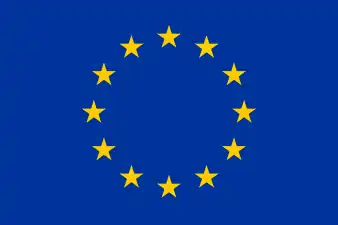 | |
| Title | Regulation (EU) 2019/1157 of the European Parliament and of the Council of 20 June 2019 on strengthening the security of identity cards of Union citizens and of residence documents issued to Union citizens and their family members exercising their right of free movement |
|---|---|
| Made by | European Parliament and Council |
| Made under | Art. 21(2) TFEU |
| Journal reference | L 188, pp. 67–78 |
| History | |
| Date made | 20 June 2019 |
| Came into force | 10 July 2019 |
| Applies from | 2 August 2021 |
| Preparative texts | |
| Commission proposal | 17 April 2018 |
| Current legislation | |
A new common format of electronic identity document is intended to replace and harmonize the various identity card models currently in use across the European Union (EU) and the European Economic Area (EEA).[lower-alpha 1] In accordance with its own laws, any Member State of the Union shall issue an identity card complying with the requirements of Regulation (EU) 2019/1157 of the European Parliament and of the Council of 20 June 2019 on strengthening the security of identity cards of Union citizens and of residence documents issued to Union citizens and their family members exercising their right of free movement, and articles 3/4/5 state that:[17]
- Identity cards shall be produced in ID-1 format and shall contain a machine-readable zone (MRZ).
- Security standards shall be based on ICAO Document 9303.
- The document shall bear the title 'Identity card' in the official language and in at least one other official language of the institutions of the Union.
- It shall contain the two-letter country code of the Member State issuing the card, printed in negative in a blue rectangle and encircled by 12 yellow stars (EU Flag) on the front side. (Requirement of the EU flag does not apply in Norway, Iceland and Liechenstein)[82]
- It shall include a highly secure storage medium which shall contain a facial image of the holder of the card and two fingerprints in interoperable digital formats. The storage medium shall have sufficient capacity and capability to guarantee the integrity, the authenticity and the confidentiality of the data. The data stored shall be accessible in contactless form and secured as provided for in Implementing Decision (European Union) C(2018) 7767.[83]
- Identity cards shall have a minimum period of validity of 5 years and a maximum period of validity of 10 years. But Member States may provide for a period of validity of less than 5 years for minors and more than 10 years for persons aged 70 and above.
- Identity cards which do not meet the new requirements shall cease to be valid at their expiry or by 3 August 2031.
- Identity cards which do not meet the minimum security standards or which do not include a functional MRZ shall cease to be valid at their expiry or by 3 August 2026.
- Identity cards of persons aged 70 and above at 2 August 2021, which meet the minimum security standards and which have a functional MRZ shall cease to be valid at their expiry.
Article 16 states that this Regulation shall apply from 2 August 2021.
- Examples of the new design standard
.png.webp) Austrian identity card
Austrian identity card_(front).png.webp) Belgian identity card
Belgian identity card.jpg.webp) Dutch identity card
Dutch identity card.webp.png.webp) Spanish identity card
Spanish identity card
For several member countries the new requirements do not mean that the design or features of the existing cards change much, since they mostly fulfil the requirements already. For some this means a large redesign. A visible change for all countries is the country code inside the EU flag.
Identity cards not meeting the new requirements shall cease to be valid at their expiry or by 3 August 2031, whichever comes sooner. Identity cards which do not meet the minimum security standards or which do not include a functional machine-readable zone shall cease to be valid by 3 August 2026. Identity cards of persons aged 70 and above on 2 August 2021 which meet the minimum security standards and which have a functional MRZ shall cease to be valid at their expiry.[84] In 2019, the EU estimated that around 80 million ID cards in circulation were not machine-readable, and will therefore expire in 2026.[85]
In addition, the new EU Regulation cannot be applied to travel documents like the passport card issued by Ireland, as stated at point (14) of the introduction chapter.[86]
Implementation throughout the member states is ongoing with various timetables on a per-country basis. Cyprus began issuing identity cards conforming to the harmonised requirements as early as August 2020, becoming the first country to implement the new standard, followed by Malta the same month.[87][13][88]
Non-compliant identity cards
In July 2023, the European Commission decided to open an infringement procedure on Bulgaria, Greece and Portugal as they have not updated their ID cards to the EU standard.[89] Greece has since released their updated ID card in September 2023. [90]
Therefore the only cards registered as national identity cards that remain non-compliant as of October 2023 are Bulgaria and Portugal.
Iceland is not yet bound (and therefore did not receive an infringement notice) as the regulation has not come into force in the EEA agreement, however a new law on Icelandic identity cards was passed and new EU-standard cards are due in December 2023. [91][92][93] The old-format Icelandic national identity card has never been a valid national identity document outside the Nordic countries, and its obscurity and lack of security meant that it was never a practical travel document. They were only written in Icelandic and did not have expiration dates, document numbers or explicit dates of birth (only displayed within the national ID no.). They did however always contain information about nationality, indicated by (e.g. "RF.IS" for Ríkisfang Ísland, meaning Citizenship: Icelandic).
Danish identity cards are issued by municipalities which have their own designs, and are not considered travel documuments valid for use outside Denmark. From 2018, information about the nationality of the cardholder was included. This briefly allowed the card to be used for travel into Sweden, but in September 2019 Swedish authorities explicitly bannad Danish municipal identity cards for entry into Sweden.[94]
Overview of national identity cards
Member states issue a variety of national identity cards with differing technical specifications and according to differing issuing procedures.[95]
| Member state | eID app | Front | Reverse | Compulsory/optional | Cost | Validity | Issuing authority | Latest version |
|---|---|---|---|---|---|---|---|---|
Austria
|
No | .png.webp) |
_(2021).png.webp) |
Identity documentation is optional |
|
|
2 August 2021[96] | |
Belgium |
EMV | _(front).png.webp) |
_(back).png.webp) |
National identity card compulsory for Belgian citizens aged 12 or over |
|
|
|
15 July 2021[97] |
Bulgaria |
No | 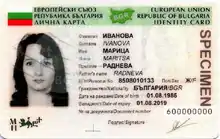 |
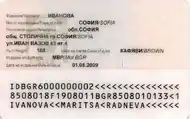 |
National identity card compulsory for Bulgarian citizens aged 14 or over |
|
|
The police on behalf of the Ministry of the Interior. | 29 March 2010 |
Croatia |
EMV |  |
_(2021).jpg.webp) |
National identity card compulsory for Croatian citizens resident in Croatia aged 18 or over |
|
|
|
2 August 2021 |
Cyprus |
No |  |
 |
National identity card compulsory for Cypriot citizens aged 12 or over |
|
|
12 August 2020 | |
Czech Republic |
EMV | 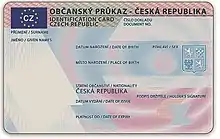 |
 |
National identity card compulsory for Czech citizens over 15 years of age with permanent residency in the Czech Republic |
|
|
|
2 August 2021 |
Denmark |
No national identity card. Danish identity cards are issued by municipalities as opposed to a central agency and therefore are not usable as travel documentation outside of the Nordic countries. (See Identity document#Denmark). | Identity documentation is optional (for Danish and Nordic citizens[3]) | — | — | — | — | ||
Estonia |
EMV | (front).jpg.webp) |
(back).jpg.webp) |
National identity card compulsory for all Estonian citizens, permanent residents and EU/EEA citizens temporarily residing in Estonia aged 15 or over |
|
5 years | Police and Border Guard Board | 23 August 2021 |
Finland |
EMV | .jpg.webp) |
.jpg.webp) |
Identity documentation is optional |
Lower fees for online appliction and with passport. |
5 years |
Police |
2 August 2021 |
France |
EMV | .png.webp) |
.png.webp) |
National identity card optional;[102] however, the police have extensive powers to check a person's identity in many situations, up to 4-hour detention to make the necessary verification and take a photograph.[103] |
|
10 years[104] |
|
15 March 2021[104] |
Germany |
NFC | .jpg.webp) |
_R%C3%BCckseite.jpg.webp) |
National identity card optional; however, a national identity card or passport is compulsory for German citizens aged 16 or over, and valid identity documentation is compulsory for other EEA citizens |
|
|
|
2 August 2021 |
Greece |
No | .png.webp) |
.png.webp) |
National identity card compulsory for Greek citizens aged 12 or over |
|
10 years |
Police |
25 September 2023[107] |
Hungary |
No | 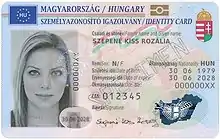 |
 |
National identity card optional; however, a national identity card, passport or driving licence is compulsory for all Hungarian citizens |
|
|
Ministry of Interior | 2 August 2021 |
Iceland |
No | 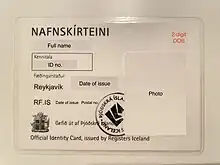 |
 |
Identity documentation is optional (for Icelandic and Nordic citizens[3]) |
|
Indefinite, or until photographic update required. | Registers Iceland (Þjóðskrá Íslands) | 12 June 1965 New law and design starting from 1 December 2023 |
Ireland |
No national identity card. Ireland issues an optional passport card, only if the applicant already has a valid passport booklet, or gets one in the same application. (See Irish passport card). | Identity documentation is optional | — | — | — | — | ||
Italy |
NFC | .jpg.webp) |
.jpg.webp) |
National identity card optional; however, citizens should be able to prove their identity if stopped by territorial police |
Note: validity must always expire on birthday[111] |
Ministry of the Interior through:
|
29 September 2022 | |
Latvia |
EMV | .png.webp) |
.png.webp) |
National identity card optional; however, a national identity card or passport is compulsory for Latvian citizens aged 15 or over. Identity cards will be compulsory starting from 2023.[112] |
|
|
Office of Citizenship and Migration Affairs | 12 October 2021 |
Liechtenstein |
EMV | 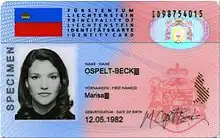 |
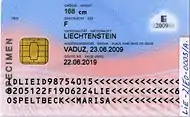 |
Identity documentation is optional |
|
|
Immigration and Passport Office, Vaduz | 23 June 2008 |
Lithuania |
EMV | _(front).png.webp) |
_(back).png.webp) |
National identity card optional; however, a national identity card or passport is compulsory for Lithuanian citizens aged 16 or over, and valid identity documentation is compulsory for other EEA citizens |
|
|
Migration Department | 17 August 2021 |
Luxembourg |
NFC[114] | .jpg.webp) |
 |
National identity card compulsory for Luxembourgian citizens resident in Luxembourg aged 15 or over |
|
|
Ministry of the Interior | 2 August 2021 |
Malta
|
No | _(front).jpg.webp) |
National identity card compulsory for Maltese citizens aged 18 or over |
|
|
|
||
Netherlands |
NFC[118] | .jpg.webp) |
.jpg.webp) |
National identity card optional; however, valid identity documentation is compulsory for all persons aged 14 or over |
|
2 August 2021[123] | ||
Norway |
No | _(Front).png.webp) |
_(Back).png.webp) |
Identity documentation is optional |
|
|
Norwegian Police Service | 29 July 2021[124][125] |
Poland |
No | National identity card compulsory for Polish citizens resident in Poland aged 18 or over. | Free of charge |
|
|
8 November 2021 | ||
Portugal |
EMV | 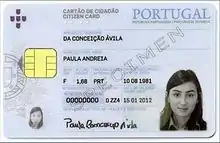 |
 |
National identity card (called "Citizen Card") compulsory for Portuguese citizens aged 6 or over |
|
|
Notary and Registry Institute (IRN) | 1 June 2009 |
Romania
|
EMV | .png.webp) |
_(2021).png.webp) |
National identity card compulsory for Romanian citizens aged 14 or over with permanent residence in Romania | 7 RON |
|
Ministry of Internal Affairs through the Directorate for Persons Record and Databases Management | 2 August 2021 (Only available in the Cluj County)
2018 (Others - old model) |
Slovakia |
EMV | 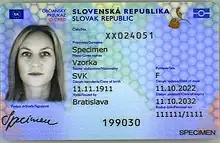 |
 |
National identity card compulsory for Slovak citizens aged 15 or over with permanent residence in Slovakia [126] |
|
|
Police | 1 December 2022 |
Slovenia |
EMV | 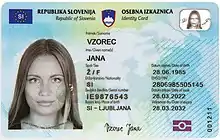 |
 |
National identity card optional; however, a form of ID with photo is compulsory for Slovenian citizens permanently resident in Slovenia aged 18 or over |
|
|
|
28 March 2022 |
Spain |
EMV | .webp.png.webp) |
.webp.png.webp) |
National identity card compulsory for Spanish citizens aged 14 or over |
|
|
2 August 2021 | |
Sweden |
No |  |
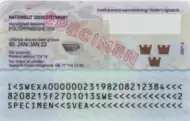 |
Identity documentation is optional | SEK 400 |
|
Swedish Police Authority | 1 January 2022[128] |
Switzerland |
No | 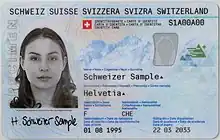 |
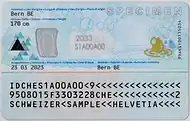 |
Identity documentation is optional |
|
|
Federal Office of Police through canton / municipality of residence | 3 March 2023[129][130] |
See also
- Passports of the European Union
- European driving licence
- European Health Insurance Card
- Citizenship of the European Union
- Visa requirements for European Union citizens
- Schengen Area
- European Economic Area
- European Free Trade Association
- List of national identity card policies by country
- Identity document
- Internal passport
Notes
- The legal acquis has been identified as EEA-relevant by the EU Commission, which makes it under scrutiny for incorporation into the EEA Agreement by Iceland, Liechtenstein and Norway.[80] However, the legal basis rely on Article 21 of the Treaty on the Functioning of the European Union, an article which is not reflected in the EEA Agreement.[81]
- The British Sovereign Base Areas of Akrotiri and Dhekelia has no border control to Cyprus and follows the visa policy of the Schengen Area, but requires permits for stays longer than 28 days per 12-month period.[30][31] These rules were not affected by Brexit.[32]
- National ID cards only accepted for short-term visits, and a passport is required to take up residency.
- Open border with the Schengen Area due to open borders with the Nordic countries (Nordic Passport Union). Citizens of EU/EFTA countries can use an ID card.
- Except for Nordic citizens, national ID cards are only accepted for short-term visits, and a passport is required to take up residency
- Only for EU, Liechtenstein and Swiss citizens.[36][37]
- On 31 December 2020, Spain and UK signed an agreement to begin negotiations for Gibraltar to join the Schengen Area.[38]
- Only machine-readable ID cards.
- Monaco is de facto part of the Schengen Area under an arrangement with France, while San Marino and Vatican City are enclaves of Italy with open land borders. For further information, see: Schengen Area § Status of the European microstates.
- Up to 14 days and only for passengers in transit to another destination. French citizens can visit Montserrat up to 6 months with their ID cards, if in possession of a return ticket to their origin country. (as stated at page 69, Section 17 of Chapter 13.01 Immigration Act)[43]
- Except Liechtenstein citizens
References
- https://eur-lex.europa.eu/legal-content/EN/TXT/?uri=CELEX:52023DC0538
- https://www.independent.co.uk/travel/news-and-advice/european-union-id-cards-brexit-passports-b1930474.html
- "Notifications under Article 37 of Regulation (EC) No 562/2006 of the European Parliament and of the Council of 15 March 2006 establishing a Community Code on the rules governing the movement of persons across borders (Schengen Borders Code). The possibility for a Member State to provide by law for an obligation to hold or carry papers and documents pursuant to Article 21(c)". Eur-lex.europa.eu. Retrieved 28 July 2022.
- "Forskrift om pass og nasjonalt ID-kort (pass- og ID-kortforskriften) - Lovdata". Lovdata.no. Retrieved 21 October 2020.
- "Who can enter Albania without a Visa" (PDF). ambasadat.gov.al.
- "BASIC INFORMATION ON ENTRY AND STAY OF ALIENS IN BOSNIA AND HERZEGOVINA". Ministry of Security of Bosnia and Herzegovina. 27 September 2016.
- "Sherbimet Konsullore". Ministry of Foreign Affairs - Republic of Kosovo.
- "Lista documentelor de călătorie emise de ţări terţe, entităţi şi autorităţi teritoriale, acceptate de Republica Moldova" [List of travel documents issued by third countries, entities and territorial authorities, accepted by the Republic of Moldova]. lex.justice.md (in Romanian). 18 September 2014.
- "Montengro Visa Regime: Norway". visit-montenegro.com.
- "Traveling to Macedonia - Visa Policy and Information". Travel Macedonia. 15 December 2021.
- "VISA Regulations". Turkish Republic of Northern Cyprus Ministry of Foreign Affairs. 4 March 2014.
- "Visa regime". Ministry of Foreign Affairs of the Republic of Serbia.
- "Get a Passport Card". Department of Foreign Affairs.
- "ID card". Þjóðskrá Íslands (www.skra.is). Archived from the original on 10 December 2020. Retrieved 30 November 2020.
- "Legitimationskort". Borger.dk. Retrieved 30 November 2020.
- REPORT FROM THE COMMISSION TO THE EUROPEAN PARLIAMENT, THE COUNCIL AND THE EUROPEAN ECONOMIC AND SOCIAL COMMITTEE pursuant to Article 13(1) of Regulation (EU) 2019/1157 of the European Parliament and of the Council of 20 June 2019 on strengthening the security of identity cards of Union citizens and of residence documents issued to Union citizens and their family members exercising their right of free movement, 2023, retrieved 23 October 2023
- "EUR-Lex - 32019R1157 - EN - EUR-Lex". eur-lex.europa.eu. Retrieved 13 September 2019.
- Articles 4 and 5 of the Citizens' Rights Directive 2004/38/EC (L 158, pp. 77–123)
- "APPENDIX 1 Movement of persons (Art. 20)" (PDF). Article 1.
- "EUR-Lex - 22002A0430(01) - EN". Official Journal L 114 , 30/04/2002, p. 0006–0072. Retrieved 19 December 2020.
- "How to use the identity card". Police. Retrieved 15 March 2021.
- "Om pass og ID-kort". Politiet (in Norwegian Bokmål). Retrieved 15 March 2021.
- "What is it? - Applying for an ID card for an adult". Police and Border Guard Board. Retrieved 20 March 2021.
- "Commission Staff Working Document - Impact Assessment accompanying the document Proposal for a Regulation of the Euoprean Parliament of the Council on strengthening the security of identity cards of Union citizens and of residence documents issued to Union citizens and their family members exercising their right of free movement" (PDF). European Commission. 17 April 2018. p. 102.
As ID cards are less bulky and usually cheaper than passports, ID card ownership is much more widespread than passport ownership and tens of millions of journeys involving entry to the EU territory are made every year using ID cards.
- "Common Travel Area between Ireland and the United Kingdom". Citizensinformation.ie. Citizens Information Board. 1 February 2020.
- Travel documents for EU nationals, europa.eu. Retrieved 30 October 2015.
- Article 5(4) of the Citizens' Rights Directive 2004/38/EC (L 158, pp. 77–123)
- Practical Handbook for Border Guards, Part II, section I, point 2.9 (C (2019) 7131)
- Judgment of the European Court of Justice of 17 February 2005, Case C 215/03, Salah Oulane vs. Minister voor Vreemdelingenzaken en Integratie
- Protocols No. 3 and 10 to the Treaty of Accession 2003, EUR-Lex, 23 September 2003.
- Control (entry, settlement and commercial enterprises) ordinance 1960, Sovereign Base Areas of Akrotiri and Dhekelia Gazette, consolidated version as of 8 October 2020.
- Protocol relating to the Sovereign Base Areas of the United Kingdom of Great Britain and Northern Ireland in Cyprus, Agreement on the withdrawal of the United Kingdom of Great Britain and Northern Ireland from the European Union and the European Atomic Energy Community, EUR-Lex, 12 November 2019.
- "Vize". Archived from the original on 6 August 2012.
- "Passport and Visa". visitfaroeislands.com. Retrieved 29 June 2022.
- "Ministry of Foreign Affairs of Georgia". Geoconsul.gov.ge. Retrieved 28 July 2022.
- "Ministry of Foreign Affairs of Georgia". Geoconsul.gov.ge. Retrieved 4 February 2021.
- "Swiss citizens allowed to enter Georgia with IDs". Agenda.ge. Retrieved 4 February 2021.
- "Brexit: Gibraltar gets UK-Spain deal to keep open border". BBC News. 31 December 2020.
- "Ballina - Ministry of Foreign Affairs - Republic of Kosovo". Mfa-ks.net. Retrieved 28 July 2022.
- "Dropbox - Error" (PDF). Dropbox.com. Retrieved 28 July 2022.
- "Archived copy". Archived from the original on 23 June 2015. Retrieved 23 June 2015.
{{cite web}}: CS1 maint: archived copy as title (link) - "Archived copy". Archived from the original on 3 October 2013. Retrieved 16 November 2015.
{{cite web}}: CS1 maint: archived copy as title (link) - "Chapter 13.01 Immigration Act of Montserrat" (PDF). Gov.ms.
- "VISA Regulations - Turkish Republic of Northern Cyprus". Mfa.gov.ct.tr. 4 March 2014.
- "Министерство за надворешни работи". Ministry of Foreign Affairs. Retrieved 28 July 2022.
- "Frequently Asked Questions". 13 January 2016.
- "CUMHURBAŞKANI KARARI" (PDF). Resmigazete.gov.tr. Retrieved 28 July 2022.
- "Archived copy" (PDF). Archived from the original (PDF) on 24 July 2014. Retrieved 18 July 2014.
{{cite web}}: CS1 maint: archived copy as title (link) - International Ministère des Affaires étrangères et du Développement. "Egypte - Sécurité". diplomatie.gouv.fr.
- "Welcome to the website of the Embassy of the Gambia in Brussels and Permanent Mission to the European Union - Travel Information". Archived from the original on 18 May 2015. Retrieved 17 May 2015.
- "Visiting the UK as an EU, EEA or Swiss citizen". GOV.UK. Retrieved 3 January 2021.
- "Government of Jersey". gov.je. Retrieved 3 January 2021.
- "Isle of Man Government - Arrival in the Isle of Man from 1 January 2021". Gov.im. Retrieved 3 January 2021.
- "Guidance for EU nationals and employers". Gov.gg. 18 November 2020. Retrieved 3 January 2021.
- "Visiting the UK: information for EU, EEA and Swiss citizens". GOV.UK. Retrieved 1 February 2020.
- "To and from Greenland". Grl-rep.dk. Retrieved 29 June 2022.
- Passlag (1978:302) (See 5§) (Swedish)
- "Ökade möjligheter att resa inom EU med nationellt identitetskort". Regeringen.se. 22 January 2015. Retrieved 28 July 2022.
- "FINLEX - Ursprungliga författningar: Statsrådets förordning om styrkande av rätten... 660/2013". Finlex.fi. Retrieved 28 July 2022.
- "Commission Staff Working Document - Impact Assessment accompanying the document Proposal for a Regulation of the Euoprean Parliament of the Council on strengthening the security of identity cards of Union citizens and of residence documents issued to Union citizens and their family members exercising their right of free movement" (PDF). European Commission. 17 April 2018. p. 12.
For instance Italian and Greek paper ID cards are frequently rejected at certain border checks (e.g. in UK, Germany and Spain). The fact that border control officials are not always familiar with the various identity documents in circulation can also result in more profound consequences, or at least, delays and inconvenience for citizens when exercising their right of free movement due to lengthy document checks.
- Regulation (EU) 2017/458 of the European Parliament and of the Council of 15 March 2017 amending Regulation (EU) 2016/399 as regards the reinforcement of checks against relevant databases at external borders (OJ L 74, 18 March 2017, p.1)
- Article 7(2) of the Schengen Borders Code in force until 6 April 2017(OJ L 105, 13 April 2006, p. 1). The amended Schengen Borders Code entered into effect on 7 April 2017: see Regulation (EU) 2017/458 of the European Parliament and of the Council of 15 March 2017 amending Regulation (EU) 2016/399 as regards the reinforcement of checks against relevant databases at external borders (OJ L 74, 18 March 2017, p.1)
- See Risk Analysis for 2016 (table of statistics of fraudulent document detected, by main countries of issuance, 2015 on p. 24) by Frontex
- See Risk Analysis for 2017 (table of statistics of fraudulent document detected, by main countries of issuance, 2016 on p. 22) by Frontex
- "Passport Card Ireland". www.gov.ie. Retrieved 1 November 2022.
- "Parliamentary question | Answer to Question No E-004933/14 | E-004933/2014(ASW) | European Parliament". Europarl.europa.eu. Retrieved 28 July 2022.
- "Right to Rent Checks: A user guide for tenants and landlords" (PDF). Assets.publishing.service.gov.uk.
- Helmbrecht, Udo; Naumann, Ingo (2011). "8: Overview of European Electronic Identity Cards". In Fumy, Walter; Paeschke, Manfred (eds.). Handbook of eID Security: Concepts, Practical Experiences, Technologies. Vol. II. John Wiley & Sons. p. 109. ISBN 978-3-89578-379-1.
- Helmbrecht, Udo; Naumann, Ingo (2011). "8: Overview of European Electronic Identity Cards". In Fumy, Walter; Paeschke, Manfred (eds.). Handbook of eID Security: Concepts, Practical Experiences, Technologies. Vol. II. John Wiley & Sons. p. 110. ISBN 978-3-89578-379-1.
- "Council of the European Union: Draft Conclusions of the Representatives of the Governments of the Member States on common minimum security standards for Member States' national identity cards" (PDF). Register.consilium.europa.eu. Retrieved 28 July 2022.
- "Council of the European Union: Draft Resolution of the Representatives of the Governments of the Member States meeting within the Council on common minimum security standards for Member States' national identity cards" (PDF). Statewatch.org.
- "List of texts adopted by the Council in the JHA area – 2006" (PDF). Archived from the original (PDF) on 12 May 2013. Retrieved 15 December 2012.
- "Machine Readable Travel Documents - Part 5" (PDF). ICAO. Retrieved 23 June 2019.
- Recital 14 to Regulation (EU) 2017/458 of the European Parliament and of the Council of 15 March 2017 amending Regulation (EU) 2016/399 as regards the reinforcement of checks against relevant databases at external borders (OJ L 74, 18 March 2017, p.1)
- "HM Government Guide" (PDF). Gov.uk.
- "Grabba - MRZ Passport - Grabba". Archived from the original on 24 November 2015. Retrieved 24 November 2015.
- "D3.6: Study on ID Documents: Future of IDentity in the Information Society". Fidis.net. Retrieved 28 July 2022.
- Privacy Features of European eID Card Specifications Authors: Ingo Naumann, Giles Hogben of the European Network and Information Security Agency (ENISA), Technical Department P.O. Box 1309, 71001 Heraklion, Greece. This article originally appeared in the Elsevier Network Security Newsletter, August 2008, ISSN 1353-4858, pp. 9-13
- "Doc 9303, Machine Readable Travel Documents, Part 5: Specifications for TD1 Size Machine Readable Official Travel Documents (MROTDs)" (PDF). ICAO.
- "320458 | European Free Trade Association". Efta.int. Retrieved 19 December 2021.
- "Fri bevegelse av personer: styrket sikkerhet av ID-kort og oppholdsdokumenter | europalov". europalov.no. Retrieved 4 September 2020.
- "320458 | European Free Trade Association". www.efta.int. Retrieved 23 October 2023.
- "Implementing decision C(2018)7767". ec.europa.eu. Retrieved 28 September 2021.
- "Status for nye pass og nasjonale ID-kort". Politiet (in Norwegian Bokmål). Retrieved 24 November 2020.
- "Press corner". European Commission - European Commission. Retrieved 24 October 2023.
- REGULATION (EU) 2019/1157 ... on strengthening the security of identity cards ... (Point 14, introduction chapter)
- "Carta d'identità". Esteri.it (in Italian). Archived from the original on 14 March 2022. Retrieved 14 March 2022.
- Chrysostomou, Annette. "New type of ID cards now being issued | Cyprus Mail". cyprus-mail.com/. Retrieved 4 October 2020.
- "July Infringements package: key decisions". PubAffairs Bruxelles. Retrieved 23 October 2023.
- "Greece to begin offering new, electronic ID cards on Monday". Greek City Times. 26 September 2023. Retrieved 26 September 2023.
- "Ný nafnskírteini sem standast kröfur". www.mbl.is (in Icelandic). Retrieved 25 April 2023.
- "Nafnskírteini | Þjóðskrá". www.skra.is. Retrieved 25 April 2023.
- "Lög um nafnskírteini". Alþingi (in Icelandic). 21 June 2023. Retrieved 20 July 2023.
- "Nyheder Legitimationskort er IKKE længere gyldigt ved rejser over Sverige". www.brk.dk (in Danish). Retrieved 25 October 2023.
- State of play concerning the electronic identity cards in the EU Member States (Council of the European Union, 2010)
- "Chip, QR-Code, wehende Fahne: Neuer Personalausweis ab 2. August". Die Presse (in German). 30 July 2021. Retrieved 30 July 2021.
- "Home". Ibz.rrn.fgov.be. Retrieved 9 August 2020.
- "Osobna iskaznica - gov.hr". gov.hr. Retrieved 14 January 2022.
- Zakon o osobnoj iskaznici Archived 8 March 2008 at the Wayback Machine (in Croatian)
- "Isikut tõendavad dokumendid". Archived from the original on 4 August 2016. Retrieved 5 May 2016.
- "Så här ansöker du om identitetskort". Polisen (in Swedish). Retrieved 14 January 2022.
- "Est-il obligatoire d'avoir une carte d'identité ?". Service-public.fr (in French). Retrieved 9 November 2019.
- "Contrôle d'identité". Service-public.fr (in French). Retrieved 9 November 2019.
- "La nouvelle carte nationale d'identité". Interieur.gouv.fr.
- "Carte d'identité et passeport (DR)". mairie.ants.gouv.fr (in French). Retrieved 11 May 2022.
- "Ministerial Decree regulating issue, reissue and renewal of Greek ID cards (recast)" (in Greek). Retrieved 26 September 2023.
- https://www.ekathimerini.com/news/1218998/example-of-new-id-cards-published/
- "Release and renew in Italy". The Electronic Identity Card (CIE). 9 December 2020. Retrieved 6 June 2022.
- "Carta d'identità – Ministero degli Affari Esteri e della Cooperazione Internazionale". Esteri.it. Retrieved 7 August 2022.
- "Electronic Identity Card (CIE)". The Electronic Identity Card (CIE). 10 December 2020. Retrieved 6 June 2022.
- "Circolare n. 7/2012 – Scadenza dei documenti di identità e di riconoscimento". Ministro per la Pubblica Amministrazione (in Italian). 20 July 2012. Retrieved 23 July 2019.
- "Personu apliecinošu dokumentu noformēšana". Pilsonības un migrācijas lietu pārvalde.
- "PRADO - LVA-BO-02001". Consilium.europa.eu.
- "eID – The Luxembourg electronic identity card". ctie.gouvernement.lu. 23 March 2021. Retrieved 23 October 2023.
- "E-ID Cards Unit". Identity Malta Agency. 8 October 2019. Retrieved 20 March 2021.
- Schmeh, Klaus (13 October 2020). "Republic of Malta launches electronic identity card". Cryptovision.com. Retrieved 20 March 2021.
- "New Maltese ID Card will enter circulation later this month". Identity Malta Agency. 28 August 2020. Retrieved 20 March 2021.
- "Identiteitsbewijs | DigiD". www.digid.nl. Retrieved 23 October 2023.
- Koninkrijksrelaties, Ministerie van Binnenlandse Zaken en (5 January 2016). "Wat kost een paspoort of identiteitskaart? - Rijksoverheid.nl". onderwerpen (in Dutch). Retrieved 7 May 2021.
- "Apply for a passport and identity card for Dutch citizens abroad". Denhaag.nl. Retrieved 7 May 2021.
- "Paspoort en identiteitskaart". Archived from the original on 10 October 2013. Retrieved 11 October 2013.
- "Identiteitskaart wordt 10 jaar geldig". Archived from the original on 21 January 2013.
- "Wijzigingen Nederlandse identiteitskaart in 2021" (PDF). Rvig.nl. Retrieved 28 July 2022.
- "Document: NOR-BO-02001". Consilium.europa.eu. Retrieved 30 July 2021.
- "Nasjonalt ID-kort Kontrollveileder" (PDF). Politiet.no. Retrieved 28 July 2022.
- "ZÁKON 395/2019 o občianskych preukazoch a o zmene a doplnení niektorých zákonov" (in Slovak).
- "Tasas de expedición del DNI". Dnielectronico.es. Retrieved 28 August 2021.
- "Nya pass och nationella identitetskort den 1 januari 2022 | Polismyndigheten". polisen.se (in Swedish). Retrieved 9 December 2021.
- Police, Federal Office of. "Passport and identity card". www.fedpol.admin.ch. Retrieved 8 February 2023.
- "Einführung der neuen Identitätskarte". www.admin.ch. Retrieved 8 February 2023.
